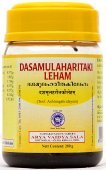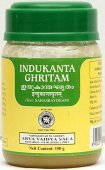Dashamula, Dasha-mula, Daśamūla, Dashan-mula: 14 definitions
Introduction:
Dashamula means something in Hinduism, Sanskrit, Marathi. If you want to know the exact meaning, history, etymology or English translation of this term then check out the descriptions on this page. Add your comment or reference to a book if you want to contribute to this summary article.
The Sanskrit term Daśamūla can be transliterated into English as Dasamula or Dashamula, using the IAST transliteration scheme (?).
In Hinduism
Ayurveda (science of life)
Veterinary Medicine (The study and treatment of Animals)
Source: Asian Agri-History: Paśu Āyurvēda (Veterinary Medicine) in GaruḍapurāṇaDaśamūla (दशमूल) refers to a group of ten roots of medicinal drugs, used in the treatment of elephants (Gajāyurveda or Hastyāyurveda), according the Garuḍapurāṇa.—The drugs, treatments enumerated in connection with diseases of horses may also be employed in the diseases of elephants. But the dosage is four times of that of a horse. In Garuḍapurāṇa a kaṣāya known as Rogasāmaka-kaṣāya mentioned for treating the diseases of elephants. It is made up of the following pacifying drugs:—[...] Daśamūla (roots of ten plants viz. Aegle marmelos, Oroxylum indicum, Premna integrifolia, Gmelina arborea, Stereospermum suaveolens, Solanum xanthocarpum, Solanum indicum, Uraria lagopodioides, Desmodium gangeticum, and Tribulus terrestris) [...].
Unclassified Ayurveda definitions
Source: Wisdom Library: Āyurveda and botanyDaśamūla (दशमूल) is the Sanskrit name for a group of medicinal plants, classified as proving beneficial in cases of Asthma and difficult respiration. It was originally composed by Suśruta in his Suśrutasaṃhitā sūtrasthāna XXXVIII, a classic work on Āyurveda. The name is derived from the words daśa (‘ten’) and mūla, translating to “root”. It includes the plants from the Laghupañcamūla and Bṛhatpañcamūla groups of medicinal plants. The collection of herbs named Daśamūla is but one of the thirty-seven gaṇas (‘sections’) of such groups.
The following plants are mentioned as belonging to this group (gaṇa):
- Śālaparṇī (Desmodium gangeticum, or “salpan”),
- Pṛśniparṇī (Uraria picta, or “pointed-leaved uraria plant”),
- Bṛhatī (Solanum indicum, or “Indian Nightshade”),
- Kaṇṭakārī (Solanum xanthocarpum, or “yellow-berried nightshade”),
- Gokṣura (Tribulus terrestris, or “land-caltrops”)
- Bilva (Aegle marmelos, or “Bengal quince”),
- Gambhārī (Gmelina beechwood, or “white teak”),
- Pāṭalā (Stereospermum suaveolens, or the “Trumpet flower tree”),
- Agnimantha (Premna serratifolia),
- Śyonāka (Oroxylum indicum, or the “Indian trumpet tree”).
The first five of these plants together form the group known as the Pañcamūla (‘five roots’).
According to the Mādhavacikitsā, the plants have medicinal properties used for the treatment of all major fevers (jvara), as described in the Jvaracikitsā (or “the treatment of fever”) chapter.
Source: Google Books: Essentials of AyurvedaDaśamūla (दशमूल).—The Sanskrit name for an important Ayurvedic drug.—Bilva, Pāṭalā, Gambhārī, Śyonāka and Agnimantha (Bṛhat pañcamūla) along with Śālaparṇī, Pṛśniparṇī, Bṛhatī, Kaṇṭakārī and Gokṣura (Laghu Pañcamūla) compose the well-known group Daśamūla (the ten roots). Daśamūla is generally useful in tridoṣa and particularly in vāta. It alleviates fever, oedema, vātika disorders and debility.
Source: archive.org: Sushruta samhita, Volume IThe two preceding groups (Mahat-panchamula and Svalpa-panchamula) in combination form the one technically known as the Dasha-Mulam (the ten roots), which is possessed of the virtue of destroying the deranged Vāta, Pittam and Kapham. It proves beneficial in cases of asthma and difficult respiration. It acts as a good digestant in respect of undigested lymph chyle, etc and is used with satisfactory results in all types of fever.
Source: PMC: Botanical identity of plant sources of Daśamūla drugsDaśamūla literally means ‘ten-roots’. The 10 plant drugs of Daśamūla are grouped as Bṛhatpañcamūla (roots of five tree species) and Laghupañcamūla (roots of five shrubs or herbs).
The Bṛhatpañcamūla are
- Bilva,
- Agnimantha,
- Śyonāka,
- Pāṭalā,
- and Gaṃbhārī
while Laghupañcamūla include
- Pṛṣṇiparṇī,
- Śālaparṇī,
- Bṛhatī,
- Kaṇṭakāri,
- and Gokṣura.
Caraka has mentioned the components of Daśamūla under the śvayathuhara-gạna i.e. the group of 10 drugs that combat oedema and uses the word Mahat Pañcamūla and Daśamūla in several contexts. Suśruta gives a classification as Bṛhatpañcamūla and Laghupañcamūla in the classification of drugs. The Ayurvedic texts have mentioned that Daśamūla plant drugs mainly pacify vāta-dośa.
Source: gurumukhi.ru: Ayurveda glossary of termsDaśamūla (दशमूल):—A combination of following ten roots obtained from Five trees Bilva(Aegle marmelos), Agnimantha(Premna mucronata), Shyonak(Oroxylum indicum), Pātla(Stereospermum suaveolens), Gambhari(Gmelina arborea)and Five plants Shālparni(Desmodium gangeticum), Prishnaparni(Uraria picta), Brahti(Solanum indicus), Kantkari(Solanum surattense), Gokshura(Tribulus terrestris).

Āyurveda (आयुर्वेद, ayurveda) is a branch of Indian science dealing with medicine, herbalism, taxology, anatomy, surgery, alchemy and related topics. Traditional practice of Āyurveda in ancient India dates back to at least the first millenium BC. Literature is commonly written in Sanskrit using various poetic metres.
Languages of India and abroad
Marathi-English dictionary
Source: DDSA: The Molesworth Marathi and English Dictionarydaśamūla (दशमूल).—n (S) A medicament prepared from the roots of ten plants.
Marathi is an Indo-European language having over 70 million native speakers people in (predominantly) Maharashtra India. Marathi, like many other Indo-Aryan languages, evolved from early forms of Prakrit, which itself is a subset of Sanskrit, one of the most ancient languages of the world.
Sanskrit dictionary
Source: DDSA: The practical Sanskrit-English dictionaryDaśamūla (दशमूल).—a tonic medicine prepared from the roots of ten plants; (Mar. sālavaṇa, piṭavaṇa (pṛṣṭiparṇī), रिंगणी, डोरली, गोखरूं, बेल, ऐरण, टेंटू, पहाडमूळ, शिवण (riṃgaṇī, ḍoralī, gokharūṃ, bela, airaṇa, ṭeṃṭū, pahāḍamūḷa, śivaṇa)).
Derivable forms: daśamūlam (दशमूलम्).
Daśamūla is a Sanskrit compound consisting of the terms daśan and mūla (मूल).
Source: Cologne Digital Sanskrit Dictionaries: Shabda-Sagara Sanskrit-English DictionaryDaśamūla (दशमूल).—n.
(-laṃ) A tonic medicament prepared from the roots of ten plants. E. daśa ten, and mūla a root.
Source: Cologne Digital Sanskrit Dictionaries: Monier-Williams Sanskrit-English DictionaryDaśamūla (दशमूल):—[=daśa-mūla] [from daśa] n. a tonic medicine prepared from 10 roots (trikaṇṭaka, both kinds of bṛhatī pṛthak-parṇī, vidāri-ganadhā, bilva, agni-mantha, tuṇṭuka, pāṭala and kāśmarī), 38; iv, 37
Source: Cologne Digital Sanskrit Dictionaries: Yates Sanskrit-English DictionaryDaśamūla (दशमूल):—[daśa-mūla] (laṃ) 1. n. A medicament prepared from the roots of 10 plants.
[Sanskrit to German]
Sanskrit, also spelled संस्कृतम् (saṃskṛtam), is an ancient language of India commonly seen as the grandmother of the Indo-European language family (even English!). Closely allied with Prakrit and Pali, Sanskrit is more exhaustive in both grammar and terms and has the most extensive collection of literature in the world, greatly surpassing its sister-languages Greek and Latin.
Kannada-English dictionary
Source: Alar: Kannada-English corpusDaśamūla (ದಶಮೂಲ):—[noun] collectively, ten kinds of medicinal herb.
Kannada is a Dravidian language (as opposed to the Indo-European language family) mainly spoken in the southwestern region of India.
See also (Relevant definitions)
Partial matches: Dasa, Mula, Tacan, Taca.
Starts with: Dashamuladi, Dashamuladi, Dashamulaghrita, Dashamulakvatha, Dashamularishta, Dashamulavishvadi.
Ends with: Ashtadashamula, Dvadashamula.
Full-text (+11): Dvipancamula, Dashamulika, Dashamuli, Gokshura, Dvadashamula, Gambhari, Dvipancamuli, Tribulus terrestris, Desmodium gangeticum, Oroxylum indicum, Stereospermum suaveolens, Uraria lagopodioides, Aegle marmelos, Solanum xanthocarpum, Solanum indicum, Gmelina arborea, Dashamulakvatha, Premna integrifolia, Svalpapancamula, Mahatpancamula.
Relevant text
Search found 16 books and stories containing Dashamula, Dasha-mula, Daśamūla, Dasamula, Daśa-mūla, Dasa-mula, Dashan-mula, Daśan-mūla, Dasan-mula; (plurals include: Dashamulas, mulas, Daśamūlas, Dasamulas, mūlas). You can also click to the full overview containing English textual excerpts. Below are direct links for the most relevant articles:
Rasa Jala Nidhi, vol 3: Metals, Gems and other substances (by Bhudeb Mookerjee)
Part 18 - Purification of Guggulu < [Chapter XXXI - Upavisha (semi-poisons)]
Part 7 - Incineration of iron (26) < [Chapter IV - Metals (4): Lauha (iron)]
Part 6 - Incineration of iron (1-25) < [Chapter IV - Metals (4): Lauha (iron)]
Rasa Jala Nidhi, vol 2: Minerals (uparasa) (by Bhudeb Mookerjee)
Part 2 - Purification of shilajatu < [Chapter IV - Uparasa (4): Shilajatu or Shilajit (bitumen)]
Sushruta Samhita, Volume 6: Uttara-tantra (by Kaviraj Kunja Lal Bhishagratna)
Chapter LXI - Symptoms and Treatment of Epilepsy (Apasmara) < [Canto IV - Bhuta-vidya-tantra (psychology and psychiatry)]
Chapter LVII - Symptoms and Treatment of aversion to food (Arochaka) < [Canto III - Kaya-chikitsa-tantra (internal medicine)]
Chapter XXXVI - Treatment of an attack by Naigamesha < [Canto II - Kaumarabhritya-tantra (pediatrics, gynecology and pregnancy)]
Atharvaveda and Charaka Samhita (by Laxmi Maji)
Treatment of Epilepsy (Mṛgī) < [Chapter 3 - Diseases and Remedial measures (described in Atharvaveda)]
Treatments of Sandhi-vāta-roga (distended joints) < [Chapter 3 - Diseases and Remedial measures (described in Atharvaveda)]
Grahaṇī (sprue-syndrome) according to Caraka < [Chapter 4 - Diseases and Remedial measures (described in Caraka-saṃhitā)]
Rasa Jala Nidhi, vol 4: Iatrochemistry (by Bhudeb Mookerjee)
Part 30 - Treatment for indigestion (28): Rasanagadi rasa < [Chapter IV - Irregularity of the digesting heat]
Treatment for fever (138): Svachchhanda-nayaka rasa < [Chapter II - Fever (jvara)]
Treatment for fever (153): Purnanada rasa < [Chapter II - Fever (jvara)]
Rasa Jala Nidhi, vol 5: Treatment of various afflictions (by Bhudeb Mookerjee)
Related products
(+27 more products available)





